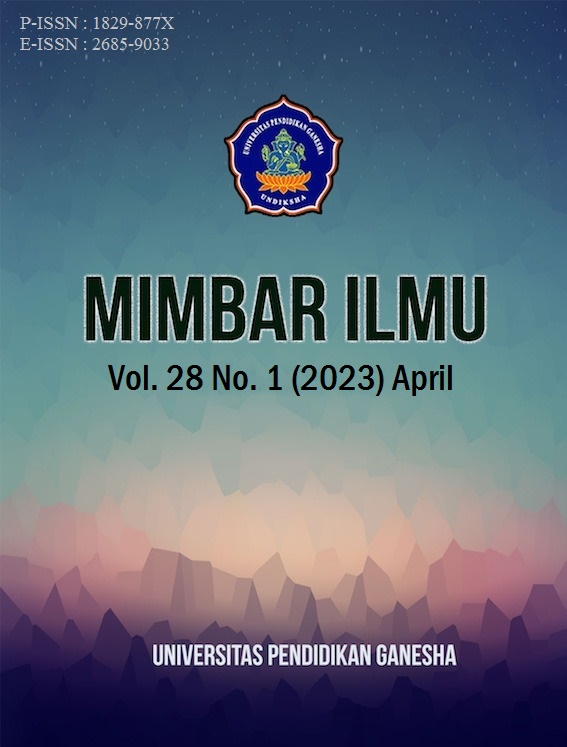The Learning Media Application "BELIPARU" Oriented Towards the Mastery of Fifth-Grade Students' Concepts of the Water Cycle Material
DOI:
https://doi.org/10.23887/mi.v28i1.57838Keywords:
media pembelajaran, aplikasi android, penguasaan konsepAbstract
The low level of mastery of concepts by elementary school students in Indonesia, especially in science subjects, impacts students' low learning outcomes and enthusiasm for participating in teaching and learning activities. So to maximize the learning process, teachers must start utilizing the use of media. This study aims to see the effectiveness of the "BELIPARU" application media, which is oriented towards mastering the concept of fifth-grade students. This research belongs to the type of development research developed using the Borg and Gall model, with four research stages consisting of the idea gathering and reference stages, product manufacturing stage, media validation stage and material validation stage, product revision stage, and trial stage. The test subjects were conducted on 29 students in class V. This data collection method was carried out through observation, written test instruments in the form of pretest and post-test questions, and closed questionnaires for students. The data obtained in this study were then analyzed using descriptive-quantitative analysis techniques through the SPSS application, which were then thoroughly described using descriptions. The research analysis showed that the media expert test produced a percentage of 92.5% in the very good category. In comparison, the results of the material experts produced a percentage of 90.6% in the very good category, although there was a slight minor revision in the validator. Furthermore, the results of the pretest activity trials showed an average of 22.24, and the results of post-test activity testing showed an average of 64.31. Based on these results, Android-based applications are very suitable for students' learning process, especially in increasing mastery of concepts.
References
Aeni, A. N., Nofriani, A. N., Fauziah, I. A., & Fauzi, I. A. (2022). Pemanfaatan Media Animasi Berbasis Aplikasi Renderforest Dalam Membentuk Kepribadian Islami Bagi Siswa Sekolah Dasar Kelas 4. Jurnal Pendidikan Dan Teknologi Indonesia, 2(6), 279–287. https://doi.org/10.52436/1.jpti.183. DOI: https://doi.org/10.52436/1.jpti.183
Agustihana, S., & Suparno. (2018). Effectiveness of Physics Mobile Learning Media to Improve Higher Order Thinking Skills of Students in Thermodynamics. Journal of Physics: Conference Series, 1097(1), 012031. https://doi.org/10.1088/1742-6596/1097/1/012031. DOI: https://doi.org/10.1088/1742-6596/1097/1/012031
Ardiansyah, A. A., & Nana, N. (2020). Peran Mobile Learning sebagai Inovasi dalam Meningkatkan Hasil Belajar Siswa pada Pembelajaran di Sekolah. Indonesian Journal Of Educational Research and Review, 3(1), 47. https://doi.org/10.23887/ijerr.v3i1.24245. DOI: https://doi.org/10.23887/ijerr.v3i1.24245
Bulkani, B., Fatchurahman, M., Adella, H., & Setiawan, M. A. (2022). Development of Animation Learning Media Based on Local Wisdom to Improve Student Learning Outcomes in Elementary Schools. International Journal of Instruction, 15(1), 55–72. https://doi.org/10.29333/iji.2022.1514a. DOI: https://doi.org/10.29333/iji.2022.1514a
Byusa, E., Kampire, E., & Mwesigye, A. R. (2022). Game-based learning approach on students’ motivation and understanding of chemistry concepts: A systematic review of literature. Heliyon, 8(5), e09541. https://doi.org/10.1016/j.heliyon.2022.e09541. DOI: https://doi.org/10.1016/j.heliyon.2022.e09541
Candra, O., Elfizon, E., Islami, S., & Yanto, D. T. P. (2020). Penerapan Multimedia Interaktif Power Point Pada Mata Diklat Dasar Dan Pengukuran Listrik. Circuit: Jurnal Ilmiah Pendidikan Teknik Elektro, 4(2), 87. https://doi.org/10.22373/crc.v4i2.6660. DOI: https://doi.org/10.22373/crc.v4i2.6660
Damayanti, P. A., & Qohar, A. (2019). Pengembangan Media Pembelajaran Matematika Interaktif Berbasis Powerpoint pada Materi Kerucut. Kreano, Jurnal Matematika Kreatif-Inovatif, 10(2), 119–124. https://doi.org/10.15294/kreano.v10i2.16814. DOI: https://doi.org/10.15294/kreano.v10i2.16814
Dapitra, A. A., Popiyanto, Y., & Suryandari, S. (2022). Pengaruh Pemanfaatan Media Power Point Terhadap Hasil Belajar IPA Materi Hubungan Antar Makhluk Hidup dan Ekosistem Siswa Kelas V SD Raden Patah Surabaya. Jurnal Pendidikan Dasar Dan Sosial Humaniora, 1(9), 2001–2008. https://bajangjournal.com/index.php/JPDSH/article/view/2844.
Diantoro, F., Purwati, E., & Lisdiawati, E. (2021). Upaya Pencapaian Tujuan Pendidikan Islam Dalam Pendidikan Nasional Dimasa Pandemi Covid-19. Ma’alim: Jurnal Pendidikan Islam, 2(01). https://doi.org/10.21154/maalim.v2i01.3035. DOI: https://doi.org/10.21154/maalim.v2i01.3035
Fardiah, F., Murwani, S., & Dhieni, N. (2019). Meningkatkan Kemampuan Kognitif Anak Usia Dini melalui Pembelajaran Sains. Jurnal Obsesi : Jurnal Pendidikan Anak Usia Dini, 4(1), 133. https://doi.org/10.31004/obsesi.v4i1.254. DOI: https://doi.org/10.31004/obsesi.v4i1.254
Febriani, C. (2017). Pengaruh Media Video terhadap Motivasi Belajar dan Hasil Belajar Kognitif Pembelajaran IPA Kelas V Sekolah Dasar. Jurnal Prima Edukasia, 5(1), 11–21. https://doi.org/10.21831/jpe.v5i1.8461. DOI: https://doi.org/10.21831/jpe.v5i1.8461
Gunawan, G., Kosim, K., Ibrahim, I., Susilawati, S., & Syukur, A. (2021). The effectiveness of physics learning tools based on discovery model with cognitive conflict approach toward student’s conceptual mastery. Journal of Physics: Conference Series, 1747(1), 012035. https://doi.org/10.1088/1742-6596/1747/1/012035. DOI: https://doi.org/10.1088/1742-6596/1747/1/012035
Handayani, M. W., Swistoro, E., & Risdianto, E. (2018). Pengaruh Model Pembelajaran Problem Solving Fisika terhadap Kemampuan Penguasaan Konsep dan Kemampuan Pemecahan Masalah Siswa Kelas X MIPA SMAN 4 Kota Bengkulu. Jurnal Kumparan Fisika, 1(3), 36–44. https://doi.org/10.33369/jkf.1.3.36-44. DOI: https://doi.org/10.33369/jkf.1.3.36-44
Hanif, S., Wijaya, A. F. C., Winarno, N., & Salsabila, E. R. (2019). The use of STEM project-based learning toward students’ concept mastery in learning light and optics. Journal of Physics: Conference Series, 1280(3), 032051. https://doi.org/10.1088/1742-6596/1280/3/032051. DOI: https://doi.org/10.1088/1742-6596/1280/3/032051
Herlina, P., & Saputra, E. R. (2022). Pengembangan Media Power point Sebagai Media Pembelajaran Bahasa Indonesia di Sekolah Dasar. Jurnal Basicedu, 6(2), 1800–1809. https://doi.org/10.31004/basicedu.v6i2.2207. DOI: https://doi.org/10.31004/basicedu.v6i2.2207
Hikmah, S. N., & Maskar, S. (2020). Pemanfaatan Aplikasi Microsoft Powerpoint Pada Siswa SMP Kelas VIII Dalam Pembelajaran Koordinat Kartesius. Jurnal Ilmiah Matematika Realistik, 1(1), 15–19. https://doi.org/10.33365/ji-mr.v1i1.215. DOI: https://doi.org/10.33365/ji-mr.v1i1.215
Lelamula, M. D., Sasinggala, M., & Paat, M. (2022). Pengaruh Model Pembelajaran Problem Based Learning Dengan Media Berbasis Power Point di Masa Pandemi Covid 19 terhadap Hasil Belajar Siswa Pada Pembelajaran IPA Biologi di SMP. Sciening : Science Learning Journal, 3(1), 22–27. https://doi.org/10.53682/slj.v3i1.1294. DOI: https://doi.org/10.53682/slj.v3i1.1294
Liu, Z.-Y., Shaikh, Z. A., & Gazizova, F. (2020). Using the Concept of Game-Based Learning in Education. International Journal of Emerging Technologies in Learning (IJET), 15(14), 53. https://doi.org/10.3991/ijet.v15i14.14675. DOI: https://doi.org/10.3991/ijet.v15i14.14675
Munirah, M., Rosdiana, & Hadmawati, N. (2022). Penggunaan Media Pembelajaran Poster Berbasis Pendekatan Saintifik Terhadap Kemampuan Kognitif Peserta Didik. Auladuna: Jurnal Pendidikan Dasar Islam, 9(1), 114–120. https://doi.org/10.24252/auladuna.v9i1a10.2022. DOI: https://doi.org/10.24252/auladuna.v9i1a10.2022
Nafisah, W. (2021). Pengembangan Media Pembelajaran Power Point Interaktif Pada Materi Gaya Dan Gerak Di Kelas Iv Sdn Tanjung Jati 1. Reseacrh Journal, 9(1). https://ejournal.undiksha.ac.id/index.php/JJL/index. DOI: https://doi.org/10.31219/osf.io/vmgfr
Nugraha, F. A., Nur’aeni, E., Suryana, Y., & Muharram, M. R. W. (2021). Efektivitas Media Powerpoint dalam Pembelajaran Materi Luas Daerah Segitiga untuk Meningkatkan Minat Belajar Peserta Didik di Sekolah Dasar. Edukatif : Jurnal Ilmu Pendidikan, 3(5), 2760–2768. https://doi.org/10.31004/edukatif.v3i5.931. DOI: https://doi.org/10.31004/edukatif.v3i5.931
Nurfadhillah, S., Ningsih, D. A., Ramadhania, P. R., & Sifa, U. N. (2021). Peranan Media Pembelajaran Dalam Meningkatkan Minat Belajar Siswa Sd Negeri Kohod III. Pensa : Jurnal Pendidikan Dan Ilmu Sosial, 3(2), 243–255. https://doi.org/10.36088/pensa.v3i2.1338.
Nurhamidah, D., Sujana, & Karlina, D. A. (2022). Pengembangan Media Berbasis Android Pada Materi Sistem Tata Surya Untuk Meningkatkan Penguasaan Konsep Siswa. Jurnal Cakrawala Pendas, 8(4), 1318–1329. https://doi.org/10.31949/jcp.v8i2.3190. DOI: https://doi.org/10.31949/jcp.v8i4.3190
Nursyaida, N., & Hardiyanti, A. (2020). Efektivitas Penggunaan Media Power Point Terhadap Hasil Belajar IPS Kelas V SD 128 Turungan Beru Kecamatan Herlang Kabupaten Bulukumba. JRPD (Jurnal Riset Pendidikan Dasar), 3(1), 71–76. https://doi.org/10.26618/jrpd.v3i1.3092. DOI: https://doi.org/10.26618/jrpd.v3i1.3092
Nuryati, N., & Darsinah, D. (2021). Implementasi Teori Perkembangan Kognitif Jean Piaget dalam Pembelajaran Matematika di Sekolah Dasar. Jurnal Papeda: Jurnal Publikasi Pendidikan Dasar, 3(2), 153–162. https://doi.org/10.36232/jurnalpendidikandasar.v3i2.1186. DOI: https://doi.org/10.36232/jurnalpendidikandasar.v3i2.1186
Octavianti, F. S. (2023). Implementasi Konvensi Hak Anak Di Kota Jakarta Utara (Studi Kasus: Pemenuhan Hak Asasi Manusia Perspektif Pendidikan Bagi Pelajar SMA). Pedagogi: Jurnal Ilmu Pendidikan, 23(1), 30–37. https://doi.org/10.24036/pedagogi.v23i1.1476. DOI: https://doi.org/10.24036/pedagogi.v23i1.1476
Pratiwi, W. N., Rochintaniawati, D., & Agustin, R. R. (2018). The effect of multiple intelligence-based learning towards students’ concept mastery and interest in learning matter. Journal of Physics: Conference Series, 1013(1), 012075. https://doi.org/10.1088/1742-6596/1013/1/012075. DOI: https://doi.org/10.1088/1742-6596/1013/1/012075
Pujianto, A. A., Degeng, I. N. S., & Sugito, S. (2020). Pengaruh penggunaan aplikasi Plantnet dan gaya belajar terhadap hasil belajar. Jurnal Inovasi Teknologi Pendidikan, 7(1), 12–22. https://doi.org/10.21831/jitp.v7i1.31365. DOI: https://doi.org/10.21831/jitp.v7i1.31365
Rahayu, R., Mustaji, M., & Bachri, B. S. (2022). Media Pembelajaran Berbasis Aplikasi Android dalam Meningkatkan Keaksaraan. Jurnal Obsesi : Jurnal Pendidikan Anak Usia Dini, 6(4), 3399–3409. https://doi.org/10.31004/obsesi.v6i4.2409. DOI: https://doi.org/10.31004/obsesi.v6i4.2409
Rais, M., Aryani, F., Ahmar, A. S., Arfandi, H., & Ahmad, W. K. (2018). Learning Media Edu-Games “My Profession” as an Effort to Introduce Various Types of Profession in Early Childhood Education Students. Journal of Physics: Conference Series, 1028(1), 012091. https://doi.org/10.1088/1742-6596/1028/1/012091. DOI: https://doi.org/10.1088/1742-6596/1028/1/012091
Sari, D. W., & Khoiri, Q. (2023). Pendidikan untuk Semua: Studi pada Kebijakan Wajib Belajar 9 Tahun. Journal on Education, 5(3), 9441–9450. https://doi.org/10.31004/joe.v5i3.1757. DOI: https://doi.org/10.31004/joe.v5i3.1757
Sarwono, R. (2022). Pengembangan Bandicam Berbasis Power Point Sebagai Media Pembelajaran Seni Rupa PGSD. Scholaria: Jurnal Pendidikan Dan Kebudayaan, 12(1), 69–73. https://doi.org/10.24246/j.js.2022.v12.i1.p69-73. DOI: https://doi.org/10.24246/j.js.2022.v12.i1.p69-73
Siahaan, K. W. A., Lumbangaol, S. T. P., Marbun, J., Nainggolan, A. D., Ritonga, J. M., & Barus, D. P. (2020). Pengaruh Model Pembelajaran Inkuiri Terbimbing dengan Multi Representasi terhadap Keterampilan Proses Sains dan Penguasaan Konsep IPA. Jurnal Basicedu, 5(1), 195–205. https://doi.org/10.31004/basicedu.v5i1.614. DOI: https://doi.org/10.31004/basicedu.v5i1.614
Sujana, I. W. C. (2019). Fungsi Dan Tujuan Pendidikan Indonesia. Adi Widya: Jurnal Pendidikan Dasar, 4(1), 29. https://doi.org/10.25078/aw.v4i1.927. DOI: https://doi.org/10.25078/aw.v4i1.927
Susilowaty, P. S. P., Aeni, A. N., & Jayadinata, A. K. (2017). Pembelajaran Berbasis Masalah untuk Meningkatkan Hasil Belajar Siswa Kelas V pada Materi Perubahan Sifat Benda. Jurnal Pena Ilmiah, 2(1), 671–680. https://ejournal.upi.edu/index.php/penailmiah/article/download/3566/pdf%0A%0A.
Tarmidzi, T., Tresnawati, N., & Sari, K. (2022). Desain Media Pembelajaran Interaktif Berbasis Aplikasi Powtoon untuk Meningkatkan Penguasaan Konsep Sains dan Konsep Diri Siswa Kelas V SD. Caruban: Jurnal Ilmiah Ilmu Pendidikan Dasar, 5(1), 82. https://doi.org/10.33603/caruban.v5i1.6419. DOI: https://doi.org/10.33603/caruban.v5i1.6419
Widhayanti, A., & Abduh, M. (2021). Penggunaan Media Audiovisual Berbantu Power Point Untuk Meningkatkan Hasil Belajar Peserta Didik di Sekolah Dasar. Jurnal Basicedu, 5(3), 1652–1657. https://doi.org/10.31004/basicedu.v5i3.975. DOI: https://doi.org/10.31004/basicedu.v5i3.975
Widia, W., Sarnita, F., Fathurrahmaniah, F., & Atmaja, J. P. (2020). Penggunaan Strategi Mind Mapping Untuk Meningkatkan Penguasaan Konsep Siswa. Jurnal Ilmiah Mandala Education, 6(2). https://doi.org/10.58258/jime.v6i2.1459. DOI: https://doi.org/10.58258/jime.v6i2.1459
Wulandari, I. G. A. A., & Putra, W. B. (2021). Pengembangan Media Pembelajaran Sistem Pencernaan Manusia Berorientasi Teori Belajar Ausubel Kelas V Sekolah Dasar. Mimbar Ilmu, 26(1), 174. https://doi.org/10.23887/mi.v26i1.31841. DOI: https://doi.org/10.23887/mi.v26i1.31841
Downloads
Published
How to Cite
Issue
Section
License
Copyright (c) 2023 Fanny Destiani, Dr. H. Atep Sujana, M.Pd., Dr. Ani Nur Aeni, M.Pd.

This work is licensed under a Creative Commons Attribution-ShareAlike 4.0 International License.
This work is licensed under a Creative Commons Attribution-ShareAlike 4.0 International License.
Authors who publish with this journal agree to the following terms:
- Authors retain copyright and grant the journal right of first publication with the work simultaneously licensed under a Creative Commons Attribution-ShareAlike 4.0 International License that allows others to share the work with an acknowledgment of the work's authorship and initial publication in this journal.
- Authors are able to enter into separate, additional contractual arrangements for the non-exclusive distribution of the journal's published version of the work (e.g., post it to an institutional repository or publish it in a book), with an acknowledgment of its initial publication in this journal.
- Authors are permitted and encouraged to post their work online (e.g., in institutional repositories or on their website) prior to and during the submission process, as it can lead to productive exchanges, as well as earlier and greater citation of published work.





